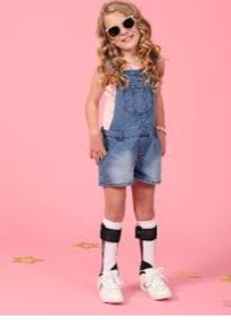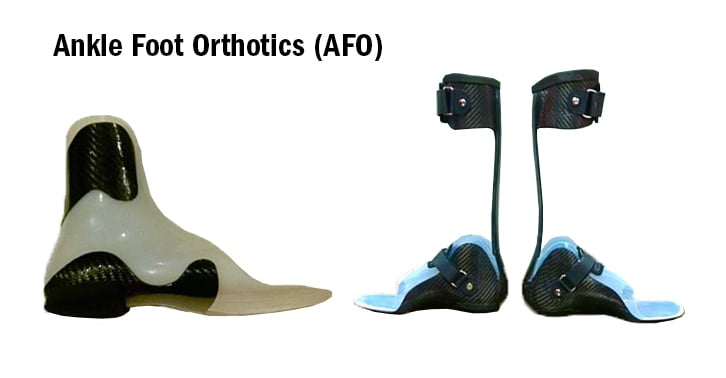When you have a child in need of an ankle-foot orthosis (AFO) the options for fit and comfort can be overwhelming. You want a good quality orthotic device, and you want your child to be able to move in it comfortably. Our orthotist will help you and your child feel at ease when trying on and wearing pediatric orthotics. At your child’s appointment, we will discuss fit, function, and style.
Your Child’s Appointment: What to Expect
During your child’s appointment, we will go over a variety of options for a custom AFO, from color and design to fit and style. You and your child will be able to choose from a variety of colors and designs to fit your child’s unique personality. We’ll also have samples available for you to look at.
A few things to keep in mind for pediatric orthotics:
- The outer plastic shell color and design
- Custom transfers
- Velcro style and color
Buying Shoes
When buying your child’s shoes, it's important that they fit properly so that your child will continue wearing the AFO. Depending on your child’s needs, your orthotist may order custom orthopedic shoes for you, or you may be able to bring in your own pair. It’s important to know that you need a specialist to determine what will work best for your child.
Here are a few tips for selecting shoes for your child to wear with an AFO:
- A shoe with a removable sole will provide more room for an orthosis.
- Shoes with an extended tongue can help ease brace fitting.
- High tops or shoes that protect the ankle may offer more overall support, but might not be able to fit an AFO.
- There are a wide variety of brands that work with AFOs, check with your provider for a list.
To help accommodate your child’s two different shoe sizes, it might be best to purchase two differently sized shoes. Try to find the smallest shoe size to accommodate an orthotic device. Wearing a shoe that’s too big can pose a tripping hazard. If you opt for a canvas shoe, you might be able to snip a few threads on the tog to increase the ease of putting on the shoe.
Any non-braced shoe may require an insert to help both legs maintain the same height.
Sock Tips
Buying a properly fitting shoe is important for a comfortable AFO fit, but the socks you buy matter, too! There are socks available that are specially designed to be worn with AFOs. It’s best to look for cotton, moisture-wicking, wrinkle-resistant socks. The socks need to be breathable and able to keep their shape.
Get Support—We Can Help!
Every family’s situation is unique, but you are not alone in this journey. A great way to ease the stress of your situation is to connect with others. We can help you connect with other families in similar situations to help you get the support you need.
When your child needs an AFO it can be overwhelming, and you may not know the options that are available—that’s where we come in. If you’re looking for high-quality orthotics from people you can trust, contact our professionals at BioTech and we’ll get your child a custom-fit they’ll love.
Your ankle foot orthosis (AFO) is vitally important to helping you move around to the best of your ability. You’ll depend on it every single day, for hours at a time, which means you have to care for your AFO and keep it in proper working condition. Not to mention, you’ll want to be as comfortable as possible, which means knowing how to wear one.
At BioTech, we help patients with their AFOs every day. Over the years, we’ve gathered tons of advice and helpful information for our patients that we’ve learned, not just from being ankle foot orthosis experts but also from listening to our patients and the feedback they’ve given us.
Here, we’ve condensed years of insight into 10 tips for wearing and caring for your AFO that you can follow to get the most from your orthotic device.
1. Wear the Right Shoe
One mistake people make is thinking that just any shoe will do, and that they can wear the same-size shoe with their AFO.
To be comfortable, wear a lace-up shoe that can fit both your foot and the AFO. You’re looking for a snug, comfortable fit that still gives room for the AFO to move around a little bit.
The heel height matters, too; you want heel height that is the same across all of your shoes. The wrong heel height will affect how you walk and the alignment of your device.
2. It’s All About the Sock
We recommend wearing a cotton sock between your skin and the AFO so that you’re more comfortable and the AFO doesn’t rub up against your exposed skin. It should be long enough that you can roll or fold the top of the sock back over the AFO, so the sock stays in place and doesn’t ride down on your leg.
Some of our patients have said that wool socks also work well because they tend to be thicker. Go with what makes you comfortable and what works best for you.
During humid times of the year, you can even sprinkle baby powder on your leg before putting on the sock to cut down on moisture and friction. Consider changing socks several times a day, too.
3. Practice Makes Perfect
People who get new AFOs tend to have problems walking with their devices at first. But, this will go away with practice. Practice does make perfect. Give yourself plenty of chances to walk around with your physical therapist - or walk around in the safety of your own home - before you venture outside.
4. Check for Pressure Areas
Sometimes, your AFO will cause pressure areas to form. These are red areas where pressure has been placed by the AFO and is causing discomfort or possibly reducing circulation in your foot.
Check for pressure areas often. If you have a reddened area that doesn’t go away after 20 minutes, make sure you keep a careful eye on it and call your orthotist if you have concerns about the fit of your AFO. An adjustment may be necessary.
Speaking of adjustments...
5. Adjustments Will Happen
Expect for you and your orthotist to have to make some adjustments to your AFO before you find the perfect fit. This is completely normal. Don’t stress out if the AFO doesn’t fit just right at the beginning. Over time, you’ll find that ideal fit through careful adjustments with your orthotic professional.
6. Start Slow
If you’ve just started wearing an AFO, you need to give your body time to adjust. So, start by wearing the brace for just an hour at a time before taking it off and resting. For the first few days, alternate between wearing the orthosis and resting your leg.
Over the next week, you can gradually increase your wearing time until you’re wearing it comfortably for as long as you need.
7. Cleaning Your Device
Your device will consist of several thermoplastic components. These need to be cleaned at least once per week. Use mild soap when cleaning these sections, and be sure to completely rinse the parts after you’re done cleaning them.
Also, don’t soak your AFO in water. Just clean it by hand and avoid soaking, which can damage your device.
8. Lubricating Your Device
The metal joints will also have to be lubricated from time to time. Your orthotist can help you find the proper type of lubricant and tell you what kind of lubrication schedule you need to be on. Proper and regular lubrication is one of the best ways you can keep your AFO working just like it should.
9. Be Careful How You Dry Your Device
AFOs are vulnerable to direct heat sources. Let them air dry at room temperature. Make sure you don’t use a hair dryer or any other source of direct heat - such as an open fire or a space heater - to dry your AFO. You can towel-dry the device, then leave it lying in the open. One way you can accelerate the device’s drying time is to use a fan.
10. Don’t Make Adjustments Yourself
It’s really tempting to want to tinker with an AFO yourself, but we highly recommend only allowing an orthotist to make adjustments. These devices are carefully designed, finely tuned pieces of equipment that need a qualified hand to adjust them.
Ankle foot orthoses are terrific devices that allow a greater degree of mobility for countless patients from all walks of life. If you have an AFO, follow these AFO care tips to keep your device - and you - working smoothly.
For more information, contact your orthotist today.
Ankle foot orthotics (AFOs) are simple and yet revolutionary. They help improve movement for people everyday who suffer from a wide variety of conditions and impairments, and are instrumental in ensuring greater mobility.
To be effective, ankle foot orthotics need to be adjusted frequently and tended to with care. They need to be properly cleaned as well. Here is more information on AFOs, including how to care for them.
What Are Ankle Foot Orthotics?
Orthotics help improve the efficiency and functionality of joints as well as increase stabilization. Ankle foot orthotics are custom designed to stabilize weak muscles and help reduce pain in joints.
Typically, the orthoses are braces that surround the ankle and foot. They are L-shaped, made of metal and/or thermoplastic. They help control the movement of the foot and ankle and adjust for development.
How to Use and Care For Your Ankle Foot Orthotic
The best way to wear your ankle foot orthotic is by wearing a shoe with laces. Try using a shoehorn if you are having trouble putting it in your shoe. Wear a size that allows for the AFO to fit in comfortably. Wearing a long sock can help.
Make sure your skin is clean and dry when you put the brace on, but know that sweat is normal. Wearing athletic socks can help with sweating.
Putting on your ankle foot orthotic can feel awkward and uncomfortable at first, so check often for pressure points, red spots, and sores. Always contact your doctor or therapist immediately if you feel pain or if you notice any blisters or marks that do not go away. If you have grown, check that the brace still fits. If your foot has grown or the brace is too snug, take your orthotic in to a specialist. A minor adjustment may be necessary.
Beyond adjustments and fit which should be tended to by a professional, caring for your brace is relatively simple.
Cleaning your brace is important. Use a little soap and a damp wash cloth. Clean the thermoplastic sections at least once a week and lubricate the metal joints when necessary. Allow the brace to air dry or towel try. Do not put it in a drying machine unless you have asked your doctor if that is okay. Often the padding, metal, and plastic found in ankle foot orthotics should not come in contact with intense heat.
It is very important to attend your follow-up appointments and heed all instructions from your specialist.
Let the Experts at BioTech Help Today
Read more about the proper care for your ankle foot orthotic at BioTech Limb and Brace. Let our experts design a brace that will improve your functionality and efficiency while still providing you with utmost comfort. We specialize in custom prosthetics and orthotics and are here to offer the support you need.
Contact us today to make an appointment.


